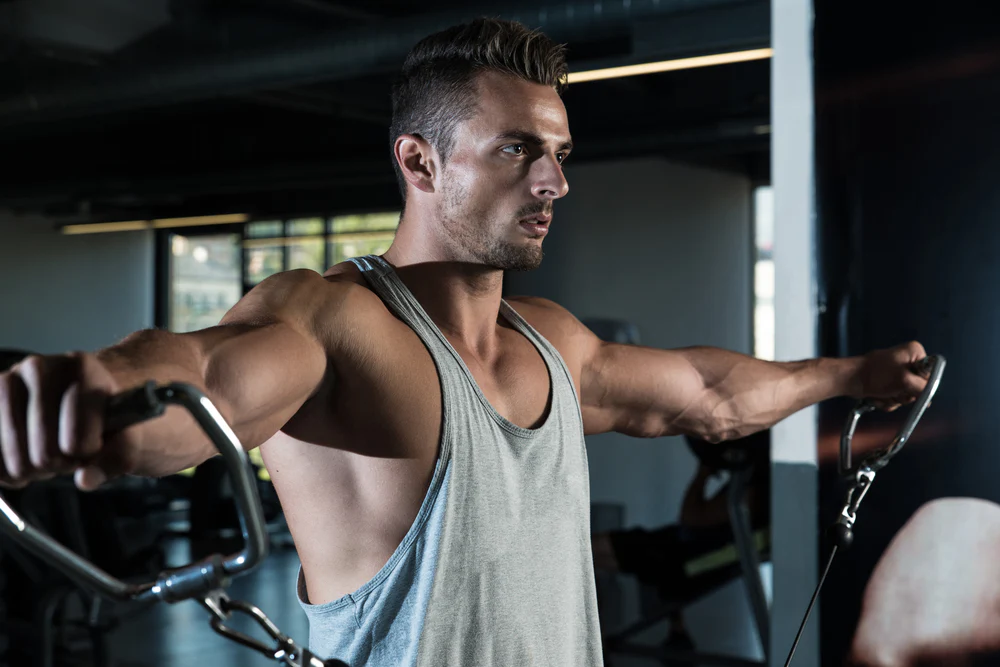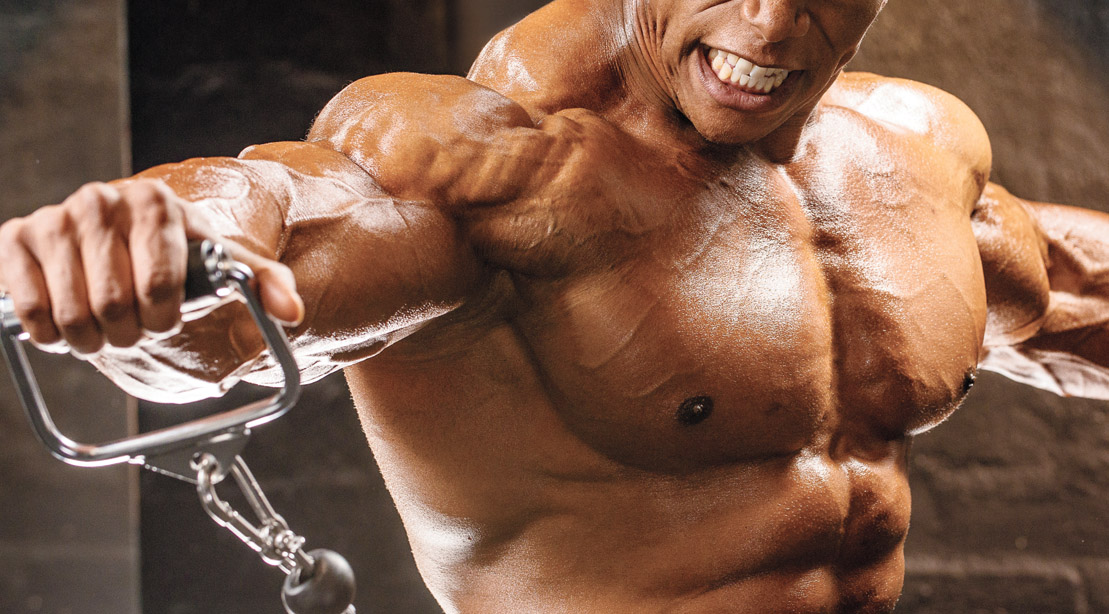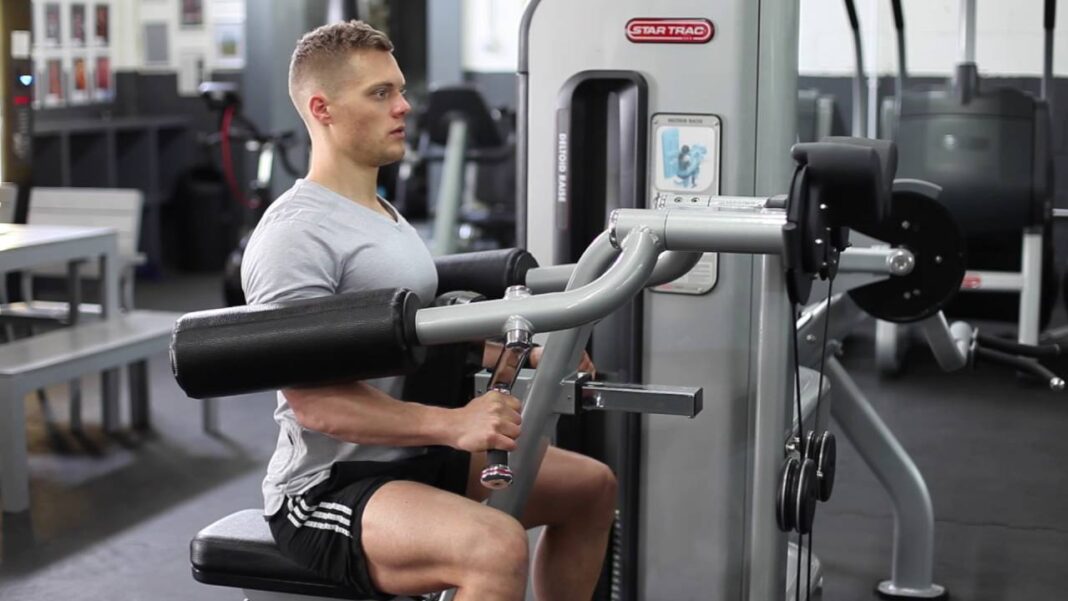Cable Lateral Raise: The Constant-Tension Builder for Wider Shoulders
If you’re chasing that 3D shoulder look—broad, round caps that give your upper body width—the side delts (lateral deltoids) are your golden ticket.
While dumbbell lateral raises are the classic move, the Cable Lateral Raise takes things to another level by providing constant tension across the entire range of motion.
Unlike dumbbells, which lose resistance at the bottom of the lift, cables keep your side delts under load from start to finish. This makes it one of the most effective hypertrophy tools for shoulder aesthetics.
In this guide, we’ll cover how to perform cable lateral raises with perfect form, variations, common mistakes, and programming strategies for strength vs aesthetics—all from a bodybuilder’s point of view.
Muscles Worked
The cable lateral raise isolates the lateral deltoid while involving several stabilizers.
- Primary Muscle:
- Lateral deltoid (side delt) – responsible for shoulder abduction (raising the arm out to the side).
- Secondary Muscles:
- Anterior deltoid – stabilizer.
- Posterior deltoid – stabilizer.
- Supraspinatus (rotator cuff) – initiates abduction.
- Trapezius & serratus anterior – stabilize scapula.
👉 Compared to dumbbells, cables keep constant side delt tension, especially at the bottom where dumbbells go slack.
How to Perform the Cable Lateral Raise (Step by Step)
Setup
- Attach a single-handle to the lowest pulley setting.
- Stand side-on to the machine, feet shoulder-width apart.
- Grip the handle with the hand furthest from the machine (cross-body start).
- Arm should hang slightly across your body, palm facing inward.
Execution
- Brace your core and keep a slight bend in the elbow.
- Raise arm out to the side in an arc until just above shoulder height.
- Pause briefly at the top, feeling the side delt contract.
- Lower slowly back to the start with control—don’t let the stack pull your arm down.
Breathing
- Inhale before lifting.
- Exhale as you raise.
Tempo Recommendation
- Up (concentric): 1–2 seconds.
- Pause: 1 second at the top.
- Down (eccentric): 2–3 seconds.
Common Mistakes and Fixes
- Going too heavy
- Mistake: Swinging the weight with traps and momentum.
- Fix: Use lighter loads; focus on strict side delt contraction.
- Shrugging shoulders
- Mistake: Letting traps dominate.
- Fix: Keep shoulders depressed—think “raise with elbows, not traps.”
- Locking elbow
- Mistake: Raising with straight arm, stressing joint.
- Fix: Maintain 10–15° elbow bend throughout.
- Short range of motion
- Mistake: Only lifting halfway.
- Fix: Raise until elbow is level with shoulder (slightly above if pain-free).
- Losing tension at bottom
- Mistake: Letting cable pull arm across body slack.
- Fix: Keep slight tension even in starting position.
Variations and Alternatives
- Single-Arm Cable Lateral Raise (Standard)
- Best isolation, constant tension.
- Two-Arm Cable Lateral Raise
- Use dual cables to work both sides at once.
- Behind-the-Back Cable Lateral Raise
- Starting from behind body increases stretch and tension.
- Incline Cable Lateral Raise
- Performed lying sideways on an incline bench with cable—maximizes range.
- Cable Y-Raise
- Raise in a Y-shape; hits side and front delts together.
- Dumbbell Lateral Raise (Alternative)
- Simpler, but less tension at bottom.
Programming Guidelines
The Cable Lateral Raise is an isolation hypertrophy exercise—don’t treat it like a heavy compound.
For Strength (Performance Focus)
- Sets/Reps: 3–4 sets of 8–10 reps.
- Rest: 90–120 seconds.
- Load: Moderate; strict, controlled reps.
- Placement: After compound presses to strengthen weak side delts.
For Hypertrophy (Aesthetics Focus)
- Sets/Reps: 3–5 sets of 12–20 reps.
- Tempo: Slow eccentric, long time under tension.
- Rest: 45–75 seconds.
- Superset Options: Pair with front raises or Arnold press for brutal delt volume.
Bodybuilder’s Tips
- Think elbows, not hands. Lead the movement with elbows to maximize side delt recruitment.
- Train unilaterally. Single-arm work allows perfect form and better focus.
- Use drop sets. Reduce weight gradually to extend sets and flood delts with blood.
- Keep slight forward lean. Shifts focus directly onto side delt fibers.
- End with burnouts. High-rep cable raises finish shoulders off after pressing.
Strength vs Aesthetic Outcomes
- Strength-Oriented Lifters: Cable lateral raises strengthen weak side delts, improving pressing stability and injury prevention.
- Aesthetic-Oriented Lifters: This is where they shine—rounding the shoulders, adding width, and completing the V-taper.
👉 For size, presses build the mass, but cables sculpt the shape.
Practical Takeaways
- The Cable Lateral Raise provides constant tension, making it one of the best isolation lifts for side delt growth.
- Strict form and light-to-moderate weight are key—ego lifting ruins the movement.
- Use variations like behind-the-back or incline cable raises for full delt development.
- For aesthetics, train in higher rep ranges (12–20) with controlled tempo and minimal rest.
- For strength, keep it secondary to compounds but use it to address side delt weaknesses.
Conclusion
If your goal is wide, round shoulders, the Cable Lateral Raise is a non-negotiable exercise. It solves the biggest limitation of dumbbells—lack of bottom-end tension—by keeping constant load on your side delts through every inch of the lift.
For bodybuilders, it’s one of the purest ways to carve out delt width and symmetry. For strength athletes, it’s an accessory that shores up pressing stability and shoulder health.
👉 Bottom line: Make Cable Lateral Raises a staple in your shoulder training—light, strict, and high volume—and watch your side delts transform into true boulder caps.





